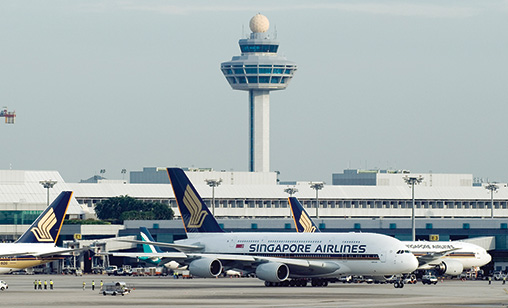News Backgrounder
Qantas bows to passenger demand for Singapore stopover
The Qantas decision to restore its Australia-London stopover to Singapore from Dubai had the two fold effect of altering its relationship with Emirates and intensifying competition out of Singapore for Singapore Airlines.
October 1st 2017
When Qantas Airways announced last month that its daily A380 service from Sydney to London via Dubai was to be returned to its former Singapore stopover, and that even more capacity was to be added from Melbourne on the service, the response Singapore Airlines (SIA) was hardly surprising. Read More »
“We prefer not to comment on our competitors,” Singapore Airlines (SIA) said about the route change, set for March 25 next year. SIA said competition was not new in the industry and “we have always faced it on every route we serve. We continue to compete by constantly introducing innovation in our products, providing good network connectivity and maintaining the high service standards that we are well known for”.
 |
 |
Others were more forthcoming. The increased capacity on these routes could hurt SIA’s yields, warned the Overseas Chinese Banking Corporation (OCBC), Singapore’s oldest local bank. “In essence, there will be increased capacity on these routes,” OCBC said.
“In our view, we estimate the South West Pacific and Europe routes form close to 50% of SIA’s total capacity. We believe London, Sydney and Melbourne are key cities that are material for SIA.
“That said, depending on the origin of sales and final destination, passengers may be indifferent about whether the stop is Singapore or Dubai. However, for SIA’s domestic market (that is Singapore), its customers have an additional airline from which to choose when flying between Singapore to London and London to Sydney or Melbourne, especially with the increased capacity.
“Hence, with Qantas’ injection of capacity onto some of SIA’s key Kangaroo routes, we expect the most direct impact would be on the yields on these routes. SIA has to compete with Qantas to fill up its aircraft, assuming demand does not grow at the same pace as capacity by 25 March next year.”
The measured SIA response comes at a time when the Singapore carrier is going through a transformation program to stem declining profitability. In May, the group reported a net profit of $259 million for the year ended March 31, a 55% drop over the $578.7 million profit of a year earlier.
SIA attributed the result, in part, to a fourth-quarter net loss of $99.3 million, reversed from a net profit of $161.9 million in the same period twelve months earlier. Like many full service airlines in the region, SIA has been hard hit by increasing competition from low-cost and Gulf carriers and Chinese airline expansion.
Qantas’ return to the traditional Kangaroo Route of Australia-Singapore-London, which it terminated in favour of Dubai in 2012, undoubtedly will add competitive pressure to carriers operating from Singapore to Europe.
Apart from the new A380 service, existing A330 daily Melbourne-Singapore flights will be upgraded to an A380. A second Melbourne-Singapore A330 three times a week service will be increased to daily.
While the Qantas change might not be the best news for SIA, Changi Airport executives were delighted. “We are pleased Qantas plans to launch a new Singapore-London service and increase seat capacity to Australia,” said Changi Airport Group managing director for Air Hub Development, Lim Ching Kiat.
“This development secures Changi Airport as the most connected international airport to Australia in terms of city links and seats. It strengthens our position as the region’s leading air hub,” he said.
“There will be more flight options to Melbourne and London, which are very popular destinations for Singaporeans. With Changi Airport as the preferred gateway for travel on the Kangaroo route, we look forward to welcoming passengers travelling between Australia and the UK. Both countries are among our top tourism source markets, and this development will spur visitor arrivals to Singapore.”
He added Changi expected Qantas and its alliance and codeshare partners would have the opportunity to develop more interlining partnerships as a result of Qantas’s increased presence in Singapore.
Qantas always has insisted it did not abandon Singapore when it announced its Emirates partnership. It operates 38 times a week from Singapore: to Brisbane, Melbourne, Perth and Sydney. This network will increase to 49 services from the 2018 Northern Summer season, including a new daily A380 service to London.
Australia is among Changi Airport’s top five country markets for passenger traffic. More than 5.5 million passengers travel between Singapore and Australia every year. For the first seven months of 2017, passenger traffic between the two countries rose 3.6% year-on-year, to 3.3 million. During the same period, Sydney and Melbourne were Changi’s 10th and 11th busiest routes, respectively.
In the meantime, if anyone believed Qantas’s increased presence out of Singapore represented a breakdown with Emirates, the recent extension of their partnership for another five years proved them wrong.
Qantas Group CEO, Alan Joyce, said the shift back to London via Singapore was decided to “reflect customer demand”. He said while the Qantas-Emirates alliance was “a great success”, the partnership has evolved to a point where Qantas no longer needs to fly its own aircraft through Dubai, which meant it could redirect some of its A380 flying into Singapore to meet strong demand in Asia.
The alliance between Qantas and Emirates remains in place, with no changes to the full codeshare and joint venture agreement. Passengers can fly on Emirates to Dubai with a choice of three stopovers between Australia and Europe: Dubai, operated by Emirates, or Perth and Singapore operated by Qantas, Joyce said. “The first five years of the Qantas-Emirates alliance has been a great success. Emirates has given Qantas customers an unbeatable network into Europe that is growing. We want to keep leveraging this strength and offer additional travel options on Qantas, particularly through Asia. “Improvements in aircraft technology mean the Qantas network will eventually feature a handful of direct routes between Australia and Europe, but this will never overtake the sheer number of destinations served by Emirates. That is why Dubai will remain an important hub for our customers,” said Joyce. Emirates Airline president, Sir Tim Clark, said: “the Emirates-Qantas partnership has been, and continues to be, a success story. Together, we deliver choice and value to consumers, mutual benefit to both businesses and expanded tourism and trade opportunities for the markets served by both airlines. “We remain committed to the partnership. Emirates has worked with Qantas on these network changes. We see an opportunity to offer customers an even stronger product proposition for travel to Dubai and onward connectivity to our extensive network in Europe, Middle East and Africa. “Customers of both airlines will benefit from the power of our joint network, from our respective products and reciprocal frequent flyer benefits.” Qantas estimates the alliance extension will deliver more than $63 million annually in net benefits, starting from the year ending June 2019. Together, Qantas and Emirates provide customers with more than 100 codeshare destinations including 33 in Europe, 60 in Australia and New Zealand, 14 in Africa and the Middle East and two in Asia. It is expected this network will grow in the next five years. |